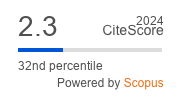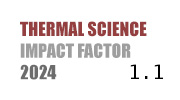THERMAL SCIENCE
International Scientific Journal
Thermal Science - Online First
online first only
Improving thermal performance and energy production of photo-voltaic thermal collector by bifurcating tree-like cooling channels
ABSTRACT
Photovoltaic thermal collectors with cooling channels suffers from poor temperature uniformity and high heat loss at high radiation intensities. However, traditional cooling channels are unable to address these specific heat dissipation requirements. In this research, the photovoltaic/thermal collector within the nature-inspired bifurcating tree-like cooling channels is designed and compared with the traditional parallel cooling channels. A theoretical model for heat exchange in the photovoltaic/thermal collector is developed. The system's performance with different structural parameters is investigated. The results indicate that the nature-inspired bifurcating tree-like II-type cooling channel exhibits superior overall performance for the photovoltaic/thermal collector. Besides, the average photovoltaic module surface temperature drops by 12.47K and the system's electric efficiency rises by 0.84% by growing the inlet speed. Furthermore, the lowest pressure drops is 13.62Pa in the cooling channel when the number of grades is 4 and the inlet mass flow rate is 0.00256kg/s. With the number of grades increasing, the average temperature of the photovoltaic module reduces. When the channel bifurcation angle is 1.0α-type and the inlet mass flow rate is 0.0124kg/s the system's electric efficiency is 13.66% and the PV/T collector's performance is optimal.
KEYWORDS
PAPER SUBMITTED: 2024-11-03
PAPER REVISED: 2024-12-12
PAPER ACCEPTED: 2024-12-20
PUBLISHED ONLINE: 2025-02-16
- Ganesan, D., et al., THERMAL STUDIES ON HEAT SINKS EXPOSED TO SOLAR IRRADIATION, Thermal Science, 28 (2024), 1A, pp. 1 - 12
- Hissouf, M., et al., Analysis of the exergy performances of a glazed and unglazed PV/T collector under different conditions, International Journal of Heat and Mass Transfer, 226 (2024), p. 125447
- Umar, M., et al., A stochastic computing procedure to solve the dynamics of prevention in HIV system, Biomedical Signal Processing and Control, 78 (2022), p. 103888
- Irem, K.,M. Tayfun, Numerical study of a photovoltaic thermal (PV/T) system using mono and hybrid nanofluid, Solar Energy, 224 (2021), pp. 1260-1270
- Alami, Y.E., et al., Numerical study of a water-based photovoltaic-thermal (PVT) hybrid solar collector with a new heat exchanger, e-Prime - Advances in Electrical Engineering, Electronics and Energy, 9 (2024), p. 100693
- Kharaz, H.E., et al., A numerical analysis of air flow topology within a vertical channel attached behind photovoltaic panel, International Journal of Heat and Mass Transfer, 223 (2024), p. 125254
- Arslan, E., et al., Numerical and experimental assessment of a photovoltaic thermal collector using variable air volume, Thermal Science and Engineering Progress, 39 (2023), p. 101735
- El Alami, Y., et al., Solar thermal, photovoltaic, photovoltaic thermal, and photovoltaic thermal phase change material systems: A comprehensive reference guide, International Communications in Heat and Mass Transfer, 159 (2024), p. 108135
- El Alami, Y., et al., Performance evaluation of different new channel box photovoltaic thermal systems, Journal of Cleaner Production, 478 (2024), p. 143953
- Kong, D., et al., Experimental study of solar photovoltaic/thermal (PV/T) air collector drying performance, Solar Energy, 208 (2020), pp. 978-989
- Faruk Can, Ö., et al., Experimental and numerical assessment of PV-TvsPV by using waste aluminum as an industrial symbiosis product, Solar Energy, 234 (2022), pp. 338-347
- Bošnjaković, M., et al., BUILDING INTEGRATED PHOTOVOLTAICS. OVERVIEW OF BARRIERS AND OPPORTUNITIES, Thermal Science, 27 (2023), 2B, pp. 1433 - 1451
- Candanedo, L., et al., NUMERICAL MODELLING OF HEAT TRANSFER IN PHOTOVOLTAIC-THERMAL AIR BASED SYSTEMS, 3rd Canadian Solar Buildings Conference. 2008: Fredericton, NB, Canada. p. 180-188
- Shen, C., et al., A numerical investigation on optimization of PV/T systems with the field synergy theory, Applied Thermal Engineering, 185 (2021), p. 116381
- Boumaaraf, B., et al., Comparison of electrical and thermal performance evaluation of a classical PV generator and a water glazed hybrid photovoltaic-thermal collector, Mathematics and Computers in Simulation, 167 (2020), pp. 176-193
- Wang, J., et al., Design and experimental study of a novel flexible PV/T structure, Energy, 296 (2024), p. 131139
- Poredoš, P., et al., Numerical and experimental investigation of the energy and exergy performance of solar thermal, photovoltaic and photovoltaic-thermal modules based on roll-bond heat exchangers, Energy Conversion and Management, 210 (2020), p. 112674
- Nahar, A., et al., Numerical and experimental investigation on the performance of a photovoltaic thermal collector with parallel plate flow channel under different operating conditions in Malaysia, Solar Energy, 144 (2017), pp. 517-528
- Shen, C., et al., Numerical study on the thermal performance of photovoltaic thermal (PV/T) collector with different parallel cooling channels, Sustainable Energy Technologies and Assessments, 45 (2021), p. 101101
- Dong, S., et al., Performance investigation of a hybrid PV/T collector with a novel trapezoidal fluid channel, Energy, 288 (2024), p. 129594
- Kong, X., et al., Numerical Study on the Optimization Design of Photovoltaic/Thermal (PV/T) Collector with Internal Corrugated Channels, International Journal of Photoenergy, 2022 (2022), p. 101101
- Xing, Y., et al., Formation of bionic surface textures composed by micro-channels using nanosecond laser on Si3N4-based ceramics, Ceramics International, 47 (2021), 9, pp. 12768-12779
- Waqas, H., et al., Numerical and Computational simulation of blood flow on hybrid nanofluid with heat transfer through a stenotic artery: Silver and gold nanoparticles, Results in Physics, 44 (2023), p. 106152
- Azeem, S., et al., Thin film flow and heat transfer of Cu-nanofluids with slip and convective boundary condition over a stretching sheet, Scientific Reports, 12 (2022), 1, pp. 14254-14254
- Madhi, H., et al., Comparative numerical study on the effect of fin orientation on the photovoltaic/thermal (PV/T) system performance, International Journal of Thermofluids, 24 (2024), p. 100909
- Chow, T.T., et al., Hybrid photovoltaic-thermosyphon water heating system for residential application, Solar Energy, 80 (2006), 3, pp. 298-306
- Zhou, J., et al., Clear-days operational performance of a hybrid experimental space heating system employing the novel mini-channel solar thermal & PV/T panels and a heat pump, Solar Energy, 155 (2017), pp. 464-477
- Zabihi Sheshpoli, A., et al., Numerical and experimental investigation on the performance of hybrid PV/thermal systems in the north of Iran, Solar Energy, 215 (2021), pp. 108-120
- Yu, Y., et al., Testing and modelling an unglazed photovoltaic thermal collector for application in Sichuan Basin, Applied Energy, 242 (2019), pp. 931-941
- Jarimi, H., et al., Bi-fluid photovoltaic/thermal (PV/T) solar collector: Experimental validation of a 2-D theoretical model, Renewable Energy, 85 (2016), pp. 1052-1067

